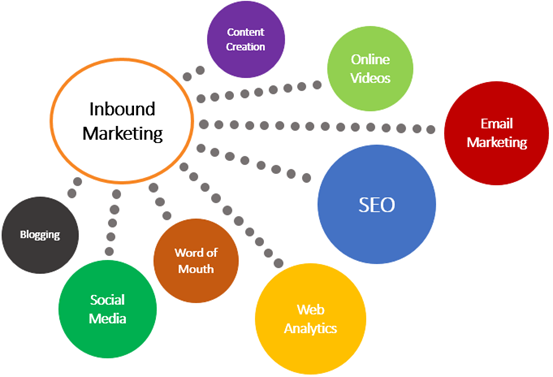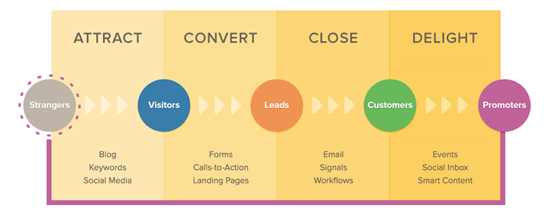In the near future we’ll release a mini-series of definitions and explanations of terms frequently used in the rapidly changing marketing and sales universe.
By the end of this post you’ll learn the main differences between of Inbound vs outbound sales! This is the first part of this series, so let’s jump in the middle of it!
Inbound marketing has become somewhat of a buzzword lately. The word ‘inbound’ simply means accepting (and cleverly guiding) the natural interest of leads towards your product or service. Cleverly, because you – as a marketing-/sales-/general manager of your business want to serve them, but instead of shouting out to them (outbound marketing), you realize that it is much more cost effective and lead-friendly to simply enable your audience to pick-and-choose things that are of interest for them at any given time.
While many blogs and articles today label ‘outbound marketing’ as something (almost) incomprehensible as to how it could have even existed, it would be wrong to accept this standpoint. See, before the advent of truly ubiquitous and fast internet, consumers and customers were not online all-day, rather in front of TV sets, driving along on roads where large billboards were put up to say ‘look here’, or sitting waiting for a bus, reading a morning (printed) paper where ads were naturally appearing to get the attention of that person to solve a problem and get them to buy something.
People did not have the opportunity to research everything (literally) before purchasing; they didn’t have the possibility to easily chat with hundreds of acquaintances about a product’s worth, or read complete strangers’ opinions on a particular service in a matter of minutes. All these phenomena came to being with the advent of Facebook, Twitter, the smartphone (predominantly the iPhone introduced in 2007). In a nutshell, you needed to interrupt your potential consumers to get their attention. With technology and the internet, these same consumers want (and seek) information on how to solve various needs and problems, and hence they come across your services, entering your world (coming inbound), instead of you going out to chase them (outbound).

Image source: https://www.vieodesign.com/blog/inbound-vs-outbound-sales-leads/
In summary, outbound sales and marketing had its merits and its necessity in its own time. Even in 2017, you should not limit yourself to inbound marketing only, but maintain a healthy balance between inbound and outbound sales and marketing activities. Think about outbound as an additional opportunity that is supported today with inbound marketing technology and content.
With outbound sales, initial contact with your company came through a sales representative (through telephone prospecting, email or another medium). With inbound marketing, the prospect comes to you herself through various channels, with the lion’s share of the job done by your content strategy.
Inbound marketing attracts your ideal customers to your company with engaging content that’s tailored to what they need and want, how they like to hear from you, and what will delight them (SEO strategy, email marketing, blogging, social media).
Inbound marketing consist of clearly articulated buyer personas that recognize each unique lead’s purchasing stage and business challenges. Some companies think in terms of account based (inbound) marketing, as some of their B2B customer companies’ activities and potential revenues are so large that it is worth putting in place a separate, tailor-made marketing and sales plan just for that customer.
 Image source: http://seopressor.com/blog/inbound-vs-outbound-marketing-more-effective/
Image source: http://seopressor.com/blog/inbound-vs-outbound-marketing-more-effective/
We already touched upon the need to have a sound content strategy. This is super important, as relevant content (for customers) attracts quality and qualified leads, that makes the work of sales teams much easier. Make sure you place your business in the wider context of issues, needs, problems, etc. that your customers find themselves dealing with. Once you succeed at this with your content strategy, customers will position you almost automatically as a trustworthy, authoritative and above all, informative and helpful company to think of. And that’s when leads turn into prospects and real customers.
Marketing automation aligns marketing and sales activity for complete visibility, accessible lead data and clear ROI tracking. B2B lead generation software Leadberry is just one magical tool in the universe of marketing automation, albeit a very effective tool to help you see leads that could turn into prospects.
 Image source: http://seopressor.com/blog/inbound-vs-outbound-marketing-more-effective/
Image source: http://seopressor.com/blog/inbound-vs-outbound-marketing-more-effective/
In summary, inbound marketing works with the way people do their research and purchasing today, using those digital channels that your target markets are active on (Google search, industry blogs, social media channels). By targeting prospects who want your help to cater to a need, your marketing content has added relevance, is not ignored, and builds trusted relationships with customers.
